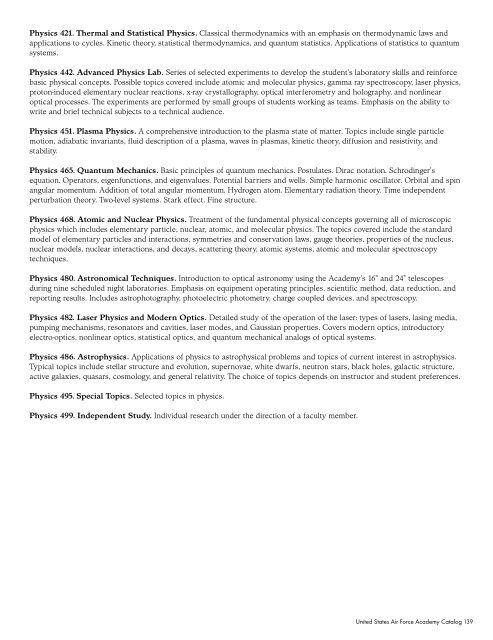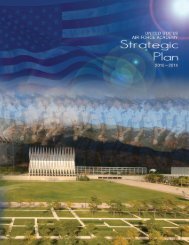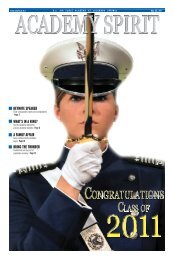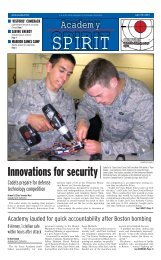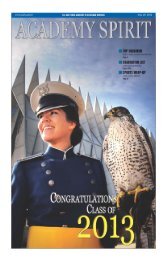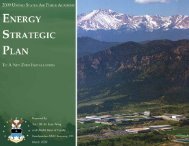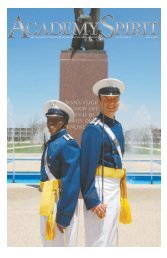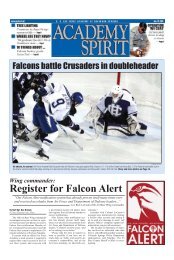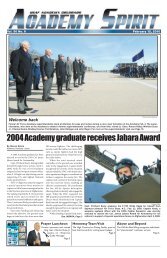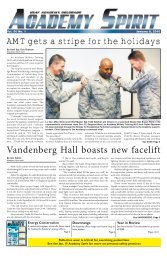2008-2009 Catalog - United States Air Force Academy
2008-2009 Catalog - United States Air Force Academy
2008-2009 Catalog - United States Air Force Academy
You also want an ePaper? Increase the reach of your titles
YUMPU automatically turns print PDFs into web optimized ePapers that Google loves.
Physics 421. Thermal and Statistical Physics. Classical thermodynamics with an emphasis on thermodynamic laws and<br />
applications to cycles. Kinetic theory, statistical thermodynamics, and quantum statistics. Applications of statistics to quantum<br />
systems.<br />
Physics 442. Advanced Physics Lab. Series of selected experiments to develop the student’s laboratory skills and reinforce<br />
basic physical concepts. Possible topics covered include atomic and molecular physics, gamma ray spectroscopy, laser physics,<br />
proton-induced elementary nuclear reactions, x-ray crystallography, optical interferometry and holography, and nonlinear<br />
optical processes. The experiments are performed by small groups of students working as teams. Emphasis on the ability to<br />
write and brief technical subjects to a technical audience.<br />
Physics 451. Plasma Physics. A comprehensive introduction to the plasma state of matter. Topics include single particle<br />
motion, adiabatic invariants, fluid description of a plasma, waves in plasmas, kinetic theory, diffusion and resistivity, and<br />
stability.<br />
Physics 465. Quantum Mechanics. Basic principles of quantum mechanics. Postulates. Dirac notation. Schrodinger’s<br />
equation. Operators, eigenfunctions, and eigenvalues. Potential barriers and wells. Simple harmonic oscillator. Orbital and spin<br />
angular momentum. Addition of total angular momentum. Hydrogen atom. Elementary radiation theory. Time independent<br />
perturbation theory. Two-level systems. Stark effect. Fine structure.<br />
Physics 468. Atomic and Nuclear Physics. Treatment of the fundamental physical concepts governing all of microscopic<br />
physics which includes elementary particle, nuclear, atomic, and molecular physics. The topics covered include the standard<br />
model of elementary particles and interactions, symmetries and conservation laws, gauge theories, properties of the nucleus,<br />
nuclear models, nuclear interactions, and decays, scattering theory, atomic systems, atomic and molecular spectroscopy<br />
techniques.<br />
Physics 480. Astronomical Techniques. Introduction to optical astronomy using the <strong>Academy</strong>’s 16” and 24” telescopes<br />
during nine scheduled night laboratories. Emphasis on equipment operating principles, scientific method, data reduction, and<br />
reporting results. Includes astrophotography, photoelectric photometry, charge coupled devices, and spectroscopy.<br />
Physics 482. Laser Physics and Modern Optics. Detailed study of the operation of the laser: types of lasers, lasing media,<br />
pumping mechanisms, resonators and cavities, laser modes, and Gaussian properties. Covers modern optics, introductory<br />
electro-optics, nonlinear optics, statistical optics, and quantum mechanical analogs of optical systems.<br />
Physics 486. Astrophysics. Applications of physics to astrophysical problems and topics of current interest in astrophysics.<br />
Typical topics include stellar structure and evolution, supernovae, white dwarfs, neutron stars, black holes, galactic structure,<br />
active galaxies, quasars, cosmology, and general relativity. The choice of topics depends on instructor and student preferences.<br />
Physics 495. Special Topics. Selected topics in physics.<br />
Physics 499. Independent Study. Individual research under the direction of a faculty member.<br />
<strong>United</strong> <strong>States</strong> <strong>Air</strong> <strong>Force</strong> <strong>Academy</strong> <strong>Catalog</strong> 139


